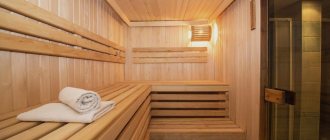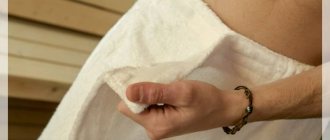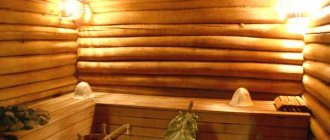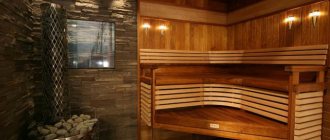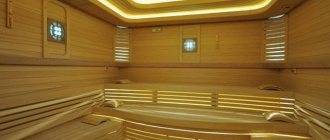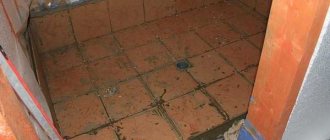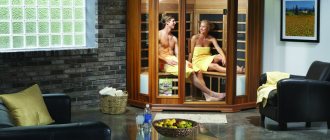Now some summer residents make crafts for the bathhouse with their own hands. Nowadays you won’t find an old Russian bathhouse; basically everything is done in a modern style. But there are elements that unite a modern and an old bathhouse - this is wood, wood carving, wooden panels and crafts. This applies not only to the interior, but also to accessories made of wood. In a Russian bath, not only the atmosphere should be appropriate, but also the furniture, various crafts, wood carvings, accessories and interior.
Accessories should not only complement and delight with their appearance, but also be functional items. That is why it is best to make them from wood. Since plastic buckets, basins, cabinets and other crafts will not create a complete picture of the bathhouse. And in people's eyes it will look like an ordinary bathroom with heating and steam.
I would like to note that the bathhouse is the kingdom of wood; only the floors, ceiling and walls are not made from it. And the equipment should only be wooden. Wood carving is very popular. Nowadays, you can buy it in any store or make it yourself.
The washing room must be equipped with benches for washing and showering. True, a shower and a Russian bath are incompatible with each other, since in ancient times people doused themselves with clean water from a tub. But in our time, people cannot refuse the benefits of civilization.
The steam room must be arranged so that people have a place to lie down. The shelves must be made of solid slats, their width should be approximately 60 cm. In no case should they be covered with special antiseptics and paints and varnishes, as all this causes severe irritation on the skin.
The wood must be sanded well. For such purposes, hardwoods are used, since under the influence of steam they do not release resins.
Aspen is considered a popular wood, and wood carvings will perfectly decorate this material.
Do not forget that you need to install a table in the steam room, on which you usually place a broom and a basin of water. But no matter how the world changes and baths improve, their appearance and some things cannot be modernized. Chopped baths are still a popular option, and the number of their lovers is increasing every year. How are wooden products for a bath made?
How to prepare a bath broom?
The bath broom is the ruler of accessories and the ruler of the Russian bath.
But to be one hundred percent sure of its environmental purity, you may need to do it yourself. At the same time, do it correctly, since otherwise it will be enough for exactly one time.
The most convenient and in most cases used broom is made from tree branches. You can choose almost any tree, but be careful, since thorns, dirt, and the risk of harmful substances escaping from the broom are, of course, not what you expect from a relaxing bath. The winners in popularity are birch and oak standards.
Really curious! If you want to get a tangible healing effect from a broom, you can prepare it from herbs, for example, from nettle. And from mint, lemon balm, wormwood.
The best branches for a broom are those that have young, small foliage (June). Oak blanks can be collected all summer - they do not quickly lose their own suitable parameters. The weather for “hunting” them should be dry and hot.
Choose narrow, straight and resilient branches. Their best length is from forty to sixty cm. It will be very problematic to tie branches that are too small.
Important! Don't be barbarians, cut suitable "material" from different trees!
Before you start knitting a broom, you need to clear the lower part of each branch from leaves and various twigs. When collecting the “elements” into a single structure, systematically shake the “bun” so that it turns out beautiful, even, dense and curly.
The technique of knitting brooms itself is, in principle, simple. The branches are fastened with synthetic strong twine. The first knitting should be placed closer to the end of the handle and tightened loosely. After which the broom is divided in half and intertwined with force: the left part is “led” through the top to the right, the right part through the bottom to the left. And without that a couple of times. The handle ultimately comes out tight, the rods do not stick out in different directions. Because the material for the broom is taken fresh, everything is twisted quite simply.
For the second tie, use the same twine, but take a piece of real twine and tie it as high and tight as possible. The ends of the “clamp” are not trimmed; they will later serve to connect the brooms into pairs. At the end of the knitting, the ends of the branches on the handle are carefully cut off with a sharp ax.
“Freshly prepared” brooms are hung in the attic to dry. Once the pages reach a brittle state, the brooms are wrapped in paper, leaving only the handle “free.” They are preserved in this form. Absolutely - in a closet or drawer, into which neither light nor dampness can reach.
The role of signs in the life of a bathhouse
Bath signs perform many functions:
- They carry a purely informative load. This is especially true if the bathhouse has a large area, is divided into many separate functional areas and new visitors to it are a common occurrence. It can be assumed that the informative nature of signs in commercial bathhouse complexes is especially acute.
- They allow you to focus on certain interior solutions, making the interior decoration of the bathhouse more complete, functional and complete.
- Cool signs for the bathhouse can show those present that the owner of the steam room is a thorough, resourceful person and is not without a sparkling sense of humor, such that right now you can send them to KVN to replace Maslyakov.
- In some cases, signs cover defects, technological holes or niches. It is especially pleasant and useful to hide a secret place under harmless boards in which two bottles of vodka, six bottles of beer and a dry ration in the form of a stick of dry-cured sausage and a liter jar of lightly salted cucumbers are stored.
Important! Naturally, you can do without signs altogether, but be mentally prepared for the fact that from time to time it will be necessary to organize full-scale search operations within the bathhouse using search dogs to find lost people.
Buckets, steamers, gangs
These wooden sauna devices can also be constructed without the help of others if you are thirsty.
To produce steamers and buckets, various types of wood are used - oak, aspen, linden. For gangs - pine, cedar. Their quantity can vary at your discretion (from 10 liters).
A set of perfectly fitted boards, a blank bottom, a metal hoop, twine, a couple of tools - and a high-quality container at your disposal. True, such amateur performances will require some abilities and serious perseverance.
In order for the devices acquired as a result of hard work to serve you for a long time, you must adhere to certain rules for their operation:
- Wood is a living material; it can dry out, become moldy, and burst. To prevent a similar problem from affecting your buckets, steamers and tubs, systematically scald them with boiling water at the end of the bath procedures. When finished, wipe dry and put away from the oven. Yes, yes, many devices for a Russian bathhouse require special care and high-quality care;
- If wood containers have not been used for a long time, they, one way or another, lose their density. Based on this, before bathing procedures, fill them to the top with cool water for a couple of hours. The material will swell and all microcracks will repair themselves. Then pour out the water and pour boiling water over the utensils to disinfect.
Worth knowing! When using oak brooms, do not be surprised that wood products that come into contact with them darken - tannins impart such a special color to any material.
Steamer for brooms as a separate type of bath utensil
At one time, we talked in detail about how to properly steam a broom. It seems like a simple operation, which, however, requires a thorough approach. A steamer for a bath is a cooper's product, which is made in the form of a deep bucket with a lid, and often the lid has special cutouts for the handles of brooms. The material for production is often linden, but it is worth noting that oak or ash are more preferable for such products. In everyday use, there are two types of steamers for brooms: with horizontal and vertical orientation of the broom. In the first case, one can note more uniform heating throughout the entire procedure, in the second - greater compactness and ease of manufacture.
Important! Darkening of the wood surface during use cannot be regarded as a defect, since with frequent use, especially when steaming oak brooms, this leads to the absorption of tannins and tannin by the surface layer. Hence the active change in the original color.
A steamer for brooms with a lid and insert is a more advanced option, since, with sufficient volume, it allows you to steam several brooms at once, which is especially interesting for large companies, with simultaneous mass visits to the steam room.
Scoop and ladle
The very first thing that the imagination draws is wooden devices. Wood for a bathhouse has a number of undoubted advantages, its low thermal conductivity is especially appreciated. But before you buy ladles for a bath (and suddenly you want to make them yourself), you should decide on the type of material from which they should be made. It is normal if it is oak, linden or aspen.
Important! To increase the service life of products, be sure to impregnate them with linseed oil or wax.
Another material widely used for the production of this type of bath utensils is metal. Products made from it have a very long service life - much longer than those made from wood.
But metal conducts heat amazingly - and this is where its hidden danger lies: there is a risk of getting burned. It is precisely on this basis that steel scoops and ladles should be equipped with wooden handles. It is better to choose (or make) devices from copper, stainless steel, brass - these materials do not corrode.
It is impossible not to mention plastic buckets and scoops. There are no contraindications to their use, unless you are really building a Russian bathhouse “for the soul” - such elements will simply stand out from a non-specialized interior.
Combined buckets can be called in demand - a plastic liner is inserted into a wooden base. Such standards are presentable on the outside and will last longer.
You should not buy into the uniqueness and style of glass products - breaking them is no more difficult than easy, in general, it is not convenient.
Important! To avoid cuts from fragments, the use of all glass accessories in the bathhouse is not recommended.
Online store of goods for baths, saunas and hammam
The online store “Ministry of Bath and Recreation” offers all lovers of healthy relaxation in a sauna, bathhouse or hammam a wide range of bath accessories.
All selected products from our catalog are delivered to the specified address promptly, at a time convenient for customers. Efficiency is one of the fundamental aspects of our work, therefore the order, after its confirmation, is sent to the addressee the very next day in one of several ways: our couriers or a transport company […].
The online store “Ministry of Bath and Recreation” has a system of discounts; various promotions are constantly held, thanks to which you can save a lot. A convenient and intuitive order form allows you to select the products you like online and submit your order in just a few clicks.
Our catalog contains the following products:
- natural bath brooms, without which it is impossible to take a quality steam bath in a Russian bath. They are made from birch branches that nourish the skin with beneficial essential oils; oak, which has healing properties and massages the skin and muscles well, rejuvenating and toning them. You can also purchase combined brooms made from branches with the addition of herbs;
- medicinal herbs: wormwood, mint, sweet clover, wild rosemary, eucalyptus. These herbs are excellent antiseptics, have a therapeutic effect on respiratory diseases, colds and viral infections, skin diseases, and have a tonic and restorative effect on the body;
- bath products made of felt and textiles: hats, rugs and mittens individually or ready-made sets, bath sheets, robes and towels, pareos for women and men's kilts;
- water containers: dousing buckets, steamers, wooden tubs and basins, ladles and mugs - all made from environmentally friendly natural materials;
- a wide range of body care and aromatherapy products are presented: natural soaps and scrubs, essential oils (individually and in sets), fragrances and evaporators;
- a wide selection of washcloths and massagers made of natural wood;
- a complete range of everything necessary for a Turkish bath - hammam: bowls for ablution, copper basins, jugs, natural soap, bags for foam, peshtemal, kese and natural oils.
In addition, the catalog of the MinBa online store presents all kinds of measuring instruments that you cannot do without in any bathhouse: clocks, hygrometers and thermometers; interior items: firewood racks and fireplace sets, headrests and rugs, bath furniture.
A bath set is a wonderful gift for family and friends, those who like to “get into the park”, and who care about their health! Our catalog contains many options for gift sets of various price ranges and configurations - from a few, the most necessary bath accessories, to more meaningful ones that can be used by the whole family or a large company.
Body brush
It is better to purchase some devices for the Russian bath, and many devices for the Turkish bath, especially which will become popular in the near future, rather than bother with creating them yourself. Since in the end it may not be exactly what you expected, and it will take a lot of time.
The brush is one of them specifically.
The main function performed by the brush is, of course, massage. Brushes for self-massage are equipped with long handles - with their help you can reach any part of the back.
These devices are made from wood, plastic, and silicone. The bristles themselves can vary in length and degree of hardness. It is advisable that it be made from natural materials, since, as experts say, artificial “lint” cleanses the skin much better.
If your bath procedures are a regular ritual, it is recommended to replace the brushes with new ones at least once every four months.
Bath utensils and accessories
Wooden utensils.
The main bath utensils are various containers with different volumes, each having its own precisely defined purpose. As a rule, the classic version involves making them exclusively from wood, most often from linden, but modern bath interiors are decorated with steel, copper, and other objects.
Wooden utensils are made exclusively using a glueless, cooperage method; they are environmentally friendly and very organic in a bathhouse interior. Often the choice of modern products is explained by a purely practical purpose - unlike wood, they do not require pre-soaking before visiting the bathhouse and do not dry out if they have not been used for some time.
Ensuring safety in the bathhouse
Bath equipment.
The bathhouse must be equipped with instruments for measuring temperature and air humidity; thermometers are even recommended to be placed in several places; for example, in a steam room they can be installed at different heights in order to have a complete understanding of the conditions in the bathhouse.
It is also difficult to do without a hygrometer in a bathhouse: knowing the humidity helps to adjust the regime. This point is especially important in the case when it is possible to adjust this parameter by arranging either a Finnish sauna, or a Russian bath, or a Turkish hammam.
It is very practical to use combined options: hygrometer/thermometer. If you purchase a thermometer separately, the choice will be between liquid alcohol models and bimetallic ones, the price of which is slightly higher.
The sauna will require a timer, or, alternatively, an hourglass to track and control the time spent in the steam room. Various types of electronic clocks are convenient, emitting sound signals at a programmed time.
Attention! Bimetallic thermometers are quite accurate, but their readings are somewhat delayed, which must be taken into account before entering the steam room.
DIY washcloth
Washcloths are an indispensable bath attribute, so it’s not at all surprising that their range in stores does not stop growing. Soft and hard, big and small, round and square, in the shape of a loop and a mitten - your eyes will run wild. You should choose based on your own taste preferences, not forgetting the degree of skin sensitivity. Since the body may not perfectly perceive natural and synthetic standards.
If you were unable to find a good version of this device in the store, you may be able to make it yourself.
Knitting washcloths is, in principle, an easy process. Select sheep, goat or any other wool that suits your needs in terms of texture and stiffness, and start making your own crafts. First, the handle for the washcloth is knitted, and then the fabric itself is knitted until it reaches the appropriate length.
Pay attention! Try to make the handle very strong - otherwise it will lose its appearance after the first contact with water.
To free a washcloth of “initial” hardness, douse it with boiling water before the first use.
Wooden sign for a bath
First we process a board about 30cm long.
First you need to prepare the board:
- find an unedged board with a thickness of 20.25 maximum 32mm. Let it be coniferous or birch: for our method the type of wood is not important.
- choose a section about 30 cm long on it, on which there are 1-2 knots. They will also look beautiful.
- Saw off the selected area from the board with a hacksaw or jigsaw.
- On such a board, unedged edges will look very impressive. You just need to remove the bark from them with a hatchet and clean the surface of the residue with a sharp knife.
- Using a sander, sand the surface until white on both sides of the board.
- remove chamfers from sharp edges with the same grinder
Your board is ready for writing on it.
Bath towel - secrets from needlewomen
If you love and can sew, making your own bath towel can be no problem. To do this you will need terry cloth and very little time.
- Sew a wide elastic band on one side (behind the previously sewn around the perimeter);
- Cover this edge with decorative fabric;
- Sew Velcro to “fasten” the towel;
- If desired and necessary, add pockets and other decorative elements to the product - everything here is at the mercy of your imagination.
DIY scented soap
The finest soap for a bath with your own hands can be prepared using an opaque soap base.
Take 100 grams of base and melt in a regular water bath.
Stirring gently, add half a teaspoon of jojoba oil, a couple of drops of glycerin and two teaspoons of dried sea aquatic plants. At the very end of cooking, add 5 drops of eucalyptus or fir essential oil. If you are thirsty, you can add a greenish dye to the mixture at this time. Stir your brew well again and pour it into the molds. Don't worry, when the soap dries, it will easily separate from the containers.
If you often make “soap” devices for baths, photos of various master classes on the Internet will definitely intrigue you. So, you will be able to improve your skills and make beautiful bath gifts for friends and relatives.
Headrest
The headrest for a bath is a very ergonomic device. It helps to achieve complete relaxation when taking procedures in a lying position.
For its production, loose wood of all species is used. It is very comfortable to make such devices for a bathhouse with your own hands, since who, if not you, knows what dimensions and configuration are more desirable for your bathhouse.
Pay special attention to the quality of grinding of parts of the product, avoid sharp edges. Make sure that there are no nails or other steel elements protruding from the headrest, as this is a possible risk of local burns.
Rules for using accessories
Of all the variety of offers on the market, wooden accessories for saunas and baths require a special approach during operation. In order to extend their “active life” you need to follow simple recommendations:
- Before purchasing, the product must be checked for leaks. In modern realities, tongue-and-groove riveting has become most widespread, that is, adjacent elements are locked together using a tongue-and-groove system, which greatly improves the quality of water retention. Products with visible defects should be rejected. Extensive fistulas are very difficult to eliminate even with prolonged soaking, about 12 - 14 days.
- Small leaks eliminate themselves after soaking, when the swollen wood, due to an increase in linear dimensions and volume, selects cracks.
- If the leak cannot be completely eliminated, you can try treating the outer surface with a hot mixture of 1 part beeswax and 2 parts linseed oil. The operation is convenient to perform using a flat brush made of natural bristles and a hair dryer. Particular attention should be paid to the processing of mornings. In some cases, it is necessary to upset the hoops using a hammer weighing 1000 - 1500 grams and a narrow copper or brass extension, shaped like a chisel with a blunt working part.
- Keep wooden accessories for baths and saunas filled with water up to the top rim.
- If this is not possible, then small-sized products should be moved to a cool, dark room and stored upside down. Opened leaks are eliminated by pre-soaking. You cannot leave empty containers in a steam room.
DIY bath hat
To prevent a visit to a bath or sauna from causing health problems, it is imperative to protect your head - with the help of bath caps. They prevent thermal shock due to the effect of the thermos.
Before you make devices for a bathhouse for such a responsible purpose, you should carefully study the types of fabrics suitable for these purposes. First, the fabric should be natural; however, neither silk nor linen are definitely suitable here. Fabrics for bath hats are made from natural wool, famous for its excellent heat-insulating qualities. Linen and cotton are used with no less furore. But the most popular materials are still felt and felt.
Really curious! Both felt and felt are made from felted wool, only felt is dense and rough, and felt is narrow and light. Felt is popularly called “generous felt.”
The felt hat is about a centimeter thick, but it's not creepy because the wool breathes. Felt is made by hand using felting from sheep wool. But don’t worry, to make a bath cap with your own hands you don’t necessarily have to bother with felting - you can easily buy it at any specialty store.
The first requirement for a bath cap is convenience. Based on this, just like with any other sewing, you need to start with a pattern.
To do this, you will need the following materials and tools:
- Pattern paper;
- Pencil;
- Awl/thick needle;
- Tailor's scissors;
- Centimeter;
- Ruler;
- Thick wool threads;
- Felt pieces.
To make a pattern, first determine the head circumference of the person for whom the hat is practically intended. Based on the taken value, calculate the size of the wedges that will make up the headdress.
The width of the wedge is a quarter of the head circumference plus one centimeter, the height is the same, only add a few, or two, or maybe more cm. Everything depends on the desired height of the future hat.
After which an isosceles triangle is constructed on paper, in which:
- The base is the width of the wedge;
- Height - the height of the wedge.
- Its corners are not rounded enough and the taken figure is cut out. The pattern is ready.
Important! To make the pattern last as long as possible, you can glue it to cardboard.
If the felt is thick, then the wedges made using simple manipulations are sewn end to end. The narrower one is sewn with a decorative seam on the front side. It is better to take visible threads so that the hat is more catchy and non-standard.
It is worth sewing a felt loop (or at least some kind of lace) into the top of the hat - the headdress will have to be hung out somehow to dry. Decorating the cap is completely and one hundred percent in your hands - you have the opportunity to trim the edge of the uniform with braid, make an applique on it from felt or any non-fading fabric, embroider a very general pattern or a sketch aimed at a specific theme.
Men's attire, at the request of the future wearer, can be embellished with a battle motto, while women's attire can be embroidered with beads, sequins, and beads. But in your zeal to make the hat unique and inimitable, try not to overdo it - this is not an element of a carnival costume.
Really curious! You can embroider the name or initials of the wearer on the cap - this way, when visiting the bathhouse with a huge group, things will not get mixed up.
Table of ranks
Accessories for a bath have a lot of shapes, sizes and purposes. We have already talked about how to create a classic “gentleman’s set” for going to the bathhouse. Today we will talk about more fundamental things. About cooperage products, which are categorically replacing plastic buckets, metal basins and other consumer goods from a thorough owner in the right bathhouse.
Barrel
A wooden container with convex walls and a solid bottom. The lid is available in two versions. It can be removable, in so-called dry barrels, the main purpose of which is the storage and transportation of bulk and bulk cargo and jellied barrels for liquids. Jellied barrels are made with greater care, and more responsible and high-quality materials are used for its production.
By the way! Particularly popular with barrels is the ability to roll them from place to place and install them vertically, without any additional supports or devices. It was the convexity, the “potbelliness” of the sides of the barrel that provided excellent rolling along the boardwalk and excellent maneuverability. At the Nizhny Novgorod fair there were virtuoso loaders who simultaneously pushed half a dozen barrels in front of them.
Barrels, as sauna accessories, serve mainly for storing large volumes of water, both hot and cold, and pickling vegetables, primarily cabbage and cucumbers, and small watermelons. Wine, beer and strong alcoholic beverages are stored in barrels by responsible bathhouse attendants. Made from noble wood varieties such as oak and ash, it is capable of creating conditions for the maturation of drinks, giving them an original bouquet and aftertaste.
By the way! There are barrels made of quite exotic wood. Thus, one of the varieties of Scandinavian aquavit, in order to acquire the original taste and aroma, must be aged only in cherry barrels.
The kit for making a barrel consists of rivets, uniform wooden planks and a bottom with a lid, which are fixed in special grooves - chimes, which makes the structure quite durable. The assembled set is fixed using hoops. Previously, this function was performed by fastened rings of young bird cherry or hazel trunks. Currently, tie hoops are made of metal, often stainless steel. Of the variety of barrels, it is worth noting their individual varieties, differing in capacity:
- Keg - a classic small barrel with a capacity of 3 to 30 liters;
- The boarder is a large container made of oak wood, which was buried up to its rim in the ground and was intended for fermenting and pickling vegetables, primarily cabbage. Some experts in old life refer to such containers not as barrels, but as tubs.
Separately, it is worth mentioning the barrels, which can be used as a separate, self-sufficient type of bathhouse. This is a Japanese bathhouse and a barrel bathhouse.
Tub
The container is cylindrical in shape, like a barrel, assembled from wooden staves and tied with hoops. The main difference between a tub and a barrel is that, in the words of V. Dahl, a great expert on the Russian language, it refers to a “stand-up vessel,” that is, it can be used exclusively in a vertical position, while the barrel can be rolled from place to place on its side, and when using stops, leave it in this position. Initially, the tub was also used as a measure of grain, however, over time it lost this practical value. In bathhouses, tubs are more common - small-volume tubs in which a wide variety of products can be stored and transported over short distances.


